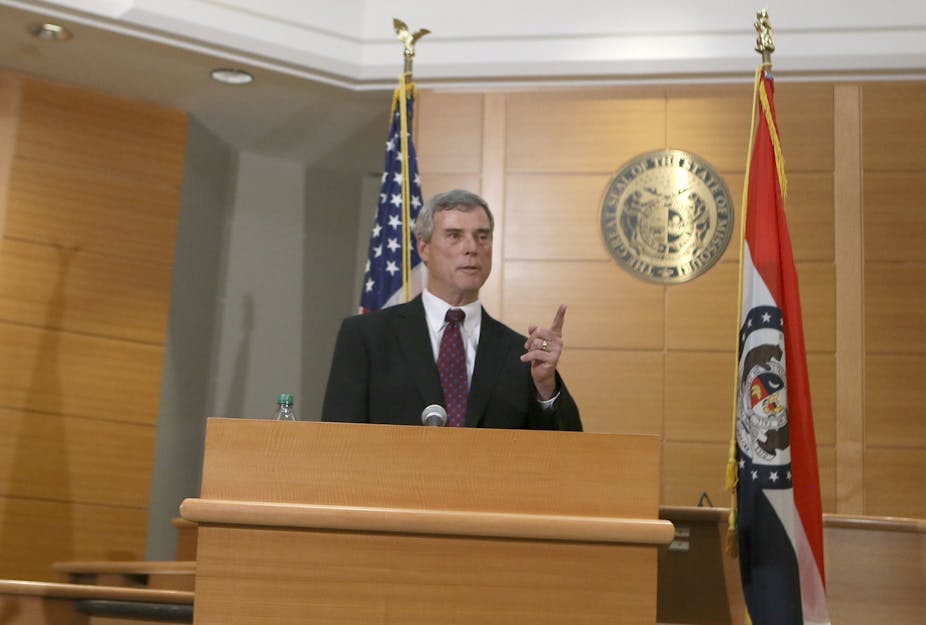Now that the grand jury has decided not to indict Officer Darren Wilson in the shooting death of Michael Brown, an unarmed 18-year old man, there remain many questions about this grand jury and generally about the use of grand juries in the United States.
The legal basis: federal and state
The fact that twelve randomly picked impartial citizens played such a key role in the matter is a unique feature of the criminal justice system in the US.
The US Constitution and all state constitutions provide for grand juries. In federal criminal cases, federal grand juries consisting of sixteen to twenty-three members make all decisions to indict, and at least twelve grand jurors are necessary in an indictment, commonly called a “true bill.”
Provisions in state constitutions vary in terms of the size of grand juries. The Missouri Constitution calls for a twelve member grand jury, nine of which must concur in an indictment.
The make up of the Ferguson grand jury
Grand jurors in St Louis County are chosen from the same jury pool as trial jurors. A judge selects the grand jurors, and the judge tries to ensure that jurors are representative of the community.
The grand jurors who heard the case involving Michael Brown’s death were chosen in May, long before his death in August.
The judge chose nine white jurors and three African American jurors. Seven jurors were men and five jurors were women. They were from all parts of St Louis County, and the percentage of African Americans (25%) on the grand jury roughly equals the percentage of African Americans (24%) in St Louis County. The grand jury’s term was originally four months long – the normal term – but a judge extended the term in order for the grand jury to consider possible charges against Darren Wilson.
The work of the grand jury
In all felony cases, there must be a “probable cause determination” that a crime has been committed. Probable cause means that there must be some evidence of each element of the offense. Most serious criminal cases usually begin with the prosecutor charging a person with one or more felonies. After the person is charged, the prosecutor has the option of bringing the case to the grand jury for the probable cause determination or to go before a judge for a probable cause determination through a preliminary hearing.
At a preliminary hearing, the accused is present along with his or her lawyer who can cross-examine witnesses. In the grand jury, however, only the prosecutor is present along with the grand jurors: both the prosecutor and the grand jurors can question each witness.
The grand jury process excludes the suspect and the defense attorney because it is not supposed to be a mini-trial but rather solely determine if there is some evidence to support felony charges. Like a preliminary hearing, it is a check on whether there is probable cause to support felony charges but is a secret proceeding that is usually much quicker than a preliminary hearing.
In St Louis County, prosecutors usually bring serious felony cases or cases with numerous witnesses to the grand jury rather than a preliminary hearing because a police officer who has investigated a case can summarize his or her findings and witness statements to present the case more quickly than at a preliminary hearing where witnesses would be examined and cross-examined.
What happened in the Darren Wilson case
In this case, the prosecutor did not bring charges against Darren Wilson. Instead, the prosecutor used the grand jury in an investigative role to determine whether to indict Darren Wilson. Under existing law, the prosecutor has discretion to proceed in this way. Unlike a regular grand jury hearing where a prosecutor presents just enough evidence to support probable cause, the grand jury heard all of the evidence that the prosecutor had on the case as it considered.
Using a grand jury in this way is unusual. Prosecutors go this route in cases involving possible excessive force by police or possible charges of corruption against elected officials. For example, a grand jury in New York City has been investigating the chokehold death of Eric Garner by a police officer since September. In August, a grand jury in Texas indicted Texas Governor Rick Perry on two felony counts for abusing his official power and coercing a public servant in an effort to force a district attorney to step down after she was arrested on drunk-driving charges.
In St Louis, Darren Wilson was permitted to testify, and he injected the defenses of a justified use of force and self-defense. The testimony by Darren Wilson is very unusual, because normally the suspect or, if charges have been filed, the accused, does not have an opportunity to testify before a grand jury. Indeed, in United States v. Williams(1992), the US Supreme Court observed that the accused neither has a right to testify nor to have the prosecution present exculpatory evidence (favorable to the defendent) to the grand jury.
Like any other witness testifying before a grand jury, Darren Wilson was not permitted to have an attorney present. The transcript of his testimony indicates that he was permitted to tell his version of what occurred. There were few hard questions put to him by either the prosecutors or any of the grand jurors.
Before the grand jury began their deliberations, the prosecutors instructed the grand jury that to return an indictment against Darren Wilson they had to find probable cause that he committed an offense. They were also told that to indict they would have to find no probable cause that either he acted in self-defense or that his use of force was justified under the law. These instructions likely led the grand jury, who heard conflicting testimony about what occurred, to decide not to indict Darren Wilson.

